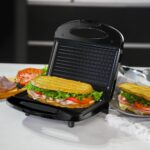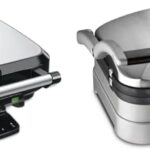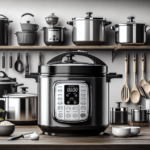So, you’ve probably heard a lot of debate about the difference between black coffee and espresso. Some say they are essentially the same thing, while others argue that they have distinct characteristics. Well, in this article, we’re going to settle this age-old coffee conundrum once and for all. We’ll explore the similarities and differences between black coffee and espresso, and uncover the truth behind whether black coffee is simply espresso with water. Get ready to sip some knowledge!
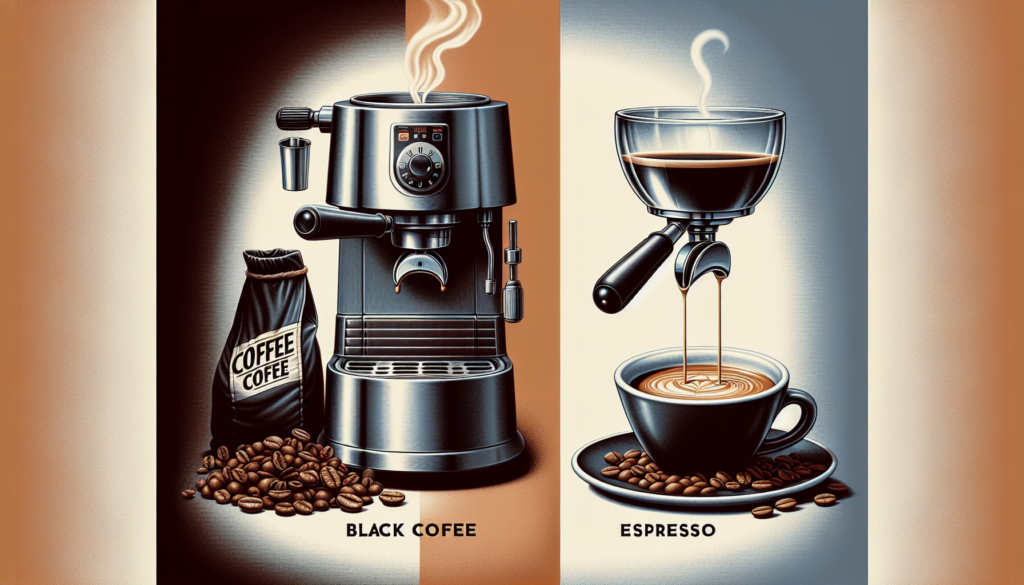
The Difference Between Black Coffee and Espresso
Definition of black coffee
Black coffee is a type of coffee beverage that is made by brewing coffee grounds with hot water. It is often served without any additives like milk or sugar, allowing the natural flavors of the coffee beans to shine through. Black coffee is enjoyed by many for its rich and bold taste.
Definition of espresso
Espresso, on the other hand, is a concentrated type of coffee that is made by forcing hot water through finely ground coffee beans with the help of pressure. It is typically served in small, strong shots and is known for its intense flavor and thick, creamy crema on top. Espresso is the base for many popular coffee drinks.
Ingredients and preparation methods
The main difference between black coffee and espresso lies in their ingredients and preparation methods. Black coffee is brewed by steeping coffee grounds in hot water, while espresso is made by forcing hot water through compacted coffee grounds with pressure.
When brewing black coffee, coarser coffee grounds are used, and water is typically heated to around 195 to 205 degrees Fahrenheit before being poured over the grounds. The brewing process takes several minutes, allowing for the extraction of the coffee’s flavors and oils.
Espresso, on the other hand, requires finely ground coffee beans and water heated to a slightly lower temperature, around 192 to 198 degrees Fahrenheit. The water is forced through the coffee grounds at high pressure, resulting in a strong and concentrated shot of coffee.
Comparing Black Coffee and Espresso
Flavor profiles
One of the key differences between black coffee and espresso is their flavor profiles. Black coffee, brewed with hot water, tends to have a more mellow and well-rounded taste. The flavors can vary depending on the type of coffee beans used, but black coffee generally has a smooth and full-bodied character.
Espresso, on the other hand, is known for its robust and intense flavor. The high-pressure extraction process used in making espresso results in a highly concentrated drink with a bold and rich taste. Espresso often has notes of caramel, chocolate, and even fruity undertones.
Caffeine content
Another factor to consider when comparing black coffee and espresso is their caffeine content. Contrary to popular belief, espresso does not contain more caffeine than black coffee. In fact, a typical shot of espresso contains less caffeine than a cup of black coffee, but due to its strong flavor, espresso may give the perception of being more caffeinated.
A standard cup (8 ounces) of black coffee contains an average of 95 milligrams of caffeine, while a single shot (1 ounce) of espresso contains about 63 milligrams. However, espresso shots are often consumed in smaller volumes, so overall caffeine intake may vary depending on the number of shots consumed.
Brewing time and pressure
The brewing time and pressure are significant differences between black coffee and espresso. Black coffee is brewed through a slower and more gradual process, which allows for the extraction of a wider range of flavors and aromas. The brewing time can range from a few minutes to several minutes, depending on the brewing method used.
Espresso, on the other hand, is brewed under high pressure and at a much faster rate. The hot water is forced through the compacted coffee grounds in a matter of seconds, resulting in a small and concentrated shot of coffee. The high-pressure extraction contributes to the intense flavor and crema characteristic of espresso.
Brewing equipment required
The brewing equipment needed for black coffee and espresso also differs. For black coffee, a traditional drip brewer, French press, or pour-over setup can be used. These methods require a coffee maker or a pot to hold the water and a filter to separate the coffee grounds from the brewed liquid.
Espresso, on the other hand, requires specific espresso machines designed to generate the necessary pressure for the extraction process. These machines come in various types, including manual lever machines, semi-automatic machines, and fully automatic machines. Espresso machines also require a grinder to grind the coffee beans finely.
Brewing Black Coffee
Traditional drip brewing
Drip brewing is one of the most common methods for brewing black coffee. It involves pouring hot water over a bed of coffee grounds held in a filter. The water drips through the coffee, extracting the flavors and oils, and collects in a pot or carafe below.
To brew black coffee using a drip brewer, you will need a coffee maker with a brewing basket and a paper or reusable filter. Simply add the desired amount of coarsely ground coffee to the filter, pour hot water into the reservoir, and turn on the machine. The water will gradually drip onto the coffee grounds, and the brewed coffee will flow into the carafe.
French press method
The French press method is another popular way to brew black coffee. It involves steeping coarsely ground coffee in hot water and then pressing a plunger to separate the brewed coffee from the grounds.
To use a French press, start by adding coarsely ground coffee to the bottom of the press. Pour hot water over the coffee, ensuring that all the grounds are saturated, and let it steep for about four minutes. Afterward, slowly press the plunger down, separating the coffee grounds from the liquid. The brewed coffee can then be poured and enjoyed.
Pour-over method
The pour-over method is a manual brewing technique that allows for greater control over the brewing process. It involves pouring hot water over a bed of coffee grounds held in a filter cone, allowing the water to flow through and extract the flavors.
To brew black coffee using the pour-over method, you will need a filter cone, a paper or reusable filter, and a kettle to heat the water. Start by placing the filter inside the cone and adding coarsely ground coffee. Place the cone over your cup or carafe, and slowly pour hot water over the coffee grounds in a circular motion. The water will flow through the filter, extracting the flavors and producing a freshly brewed cup of black coffee.
Brewing Espresso
Espresso machine
Brewing espresso requires the use of an espresso machine, which is specifically designed to produce the high pressure needed for extraction. Espresso machines come in various sizes, from compact home machines to large commercial ones, and they can range from fully manual to fully automatic.
Different types of espresso machines
There are three main types of espresso machines: manual lever machines, semi-automatic machines, and fully automatic machines.
Manual lever machines require the user to manually operate a lever to generate the pressure needed for extraction. These machines offer precise control over the brewing process but require more skill and practice.
Semi-automatic machines are the most common type of espresso machine used in homes and cafes. They feature a pump system that generates the necessary pressure, along with temperature controls and other features for consistent extraction.
Fully automatic machines take much of the guesswork out of brewing espresso. These machines handle the entire brewing process, from grinding the beans to extracting the shot, with the push of a button. They are a convenient option for those seeking ease of use.
The espresso shot process
To brew espresso, the process starts with grinding the coffee beans finely. The ground coffee is then evenly distributed and compacted into a portafilter, a device that holds the coffee grounds. The portafilter is then locked into the espresso machine.
Once the machine is turned on, hot water is forced through the coffee grounds in the portafilter under high pressure. The water extracts the flavors and oils from the coffee, resulting in a concentrated shot of espresso. The shot typically takes around 25 to 30 seconds to brew and should have a thick layer of crema on top, indicating a well-extracted shot.
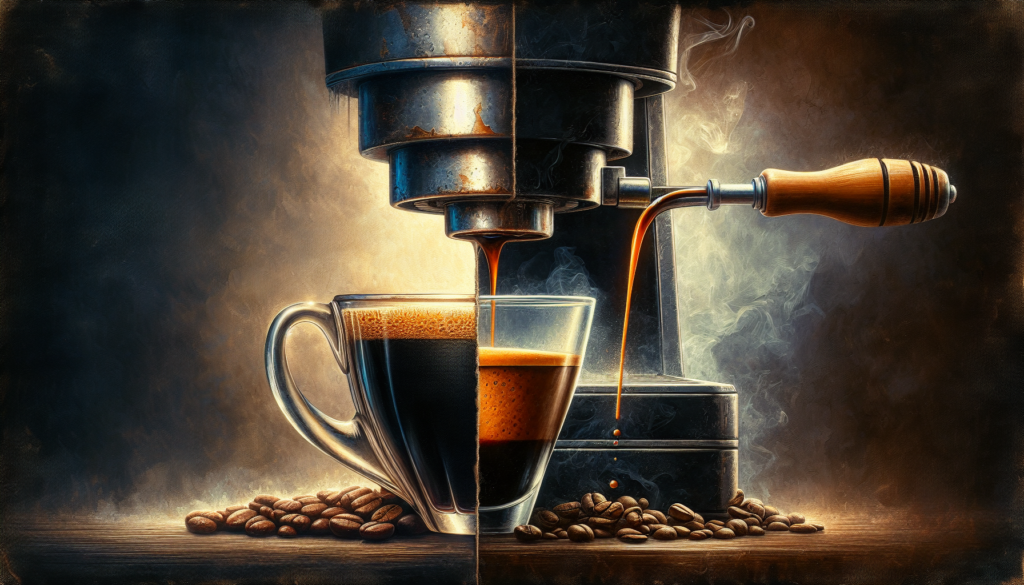
The Role of Water in Coffee Extraction
Effect of water quality on flavor
Water quality plays a crucial role in coffee extraction, as it can significantly impact the flavor of both black coffee and espresso. The minerals and impurities present in water can affect the taste and clarity of the brewed coffee.
Ideally, water used for brewing coffee should be clean and free from strong odors or flavors. It should also have a balanced mineral content to enhance the flavors of the coffee. Tap water can be used if it meets these criteria, or filtered water can be used to ensure optimal water quality.
Water temperature and extraction
The temperature of the water used for brewing black coffee and espresso also affects the extraction process. Water that is too hot can result in over-extracted, bitter coffee, while water that is too cold can lead to under-extraction and a weak taste.
For black coffee, the water temperature should be between 195 to 205 degrees Fahrenheit. This range allows for proper extraction of the coffee flavors without scorching or under-extracting the beans.
In the case of espresso, the water temperature is slightly lower, ranging from 192 to 198 degrees Fahrenheit. This temperature range helps to prevent the extraction from becoming too bitter while still extracting the desired flavors of the coffee beans.
Water-to-coffee ratio
Achieving the right water-to-coffee ratio is essential for brewing both black coffee and espresso. The ratio determines the strength and concentration of the final brew.
For black coffee, a commonly used ratio is one to two tablespoons of coffee grounds per six ounces of water. This can be adjusted based on personal taste preferences, with some individuals preferring a stronger brew and others opting for a milder cup.
In the case of espresso, the ratio is typically one part coffee grounds to two parts water. Since espresso shots are highly concentrated, using too much coffee or too little water can result in an imbalanced and overly intense flavor.
Coffee Varieties in Espresso and Black Coffee
Coffee bean origins
The coffee beans used for both espresso and black coffee can come from various regions around the world. Different regions are known for producing coffee beans with distinct flavors and characteristics.
For black coffee, a wider variety of coffee beans can be used, and personal taste preferences often guide the selection. Popular choices include Arabica beans, which are known for their smooth and nuanced flavors, and Robusta beans, which have a stronger taste and higher caffeine content.
Espresso, on the other hand, often utilizes a blend of different coffee beans to achieve a balanced and complex flavor profile. These blends can consist of Arabica and Robusta beans in varying ratios, each contributing to the overall taste of the espresso.
Roast levels for different brews
The roast level of the coffee beans also plays a role in the flavor profiles of black coffee and espresso. Roasting coffee beans brings out different flavors and intensifies the taste.
For black coffee, the roast level can vary depending on personal preference. Lighter roasts tend to preserve more of the bean’s natural flavors, resulting in a brighter and more acidic cup. Medium roasts strike a balance between preserving the origin flavors and developing the coffee’s sweetness and body. Dark roasts, on the other hand, have a bolder and smokier taste.
Espresso beans are typically roasted to a medium to dark level. This allows the flavors to be intensified and developed during the extraction process. The roasting process also plays a role in creating the thick crema layer characteristic of espresso shots.
Blends and single-origin coffees
In both black coffee and espresso, blends and single-origin coffees are commonly used. Blends are created by combining different coffee beans to achieve a desired flavor profile and consistency. These blends often aim to balance the characteristics of different beans to create a well-rounded cup of coffee.
Single-origin coffees, on the other hand, come from a specific region or farm, offering unique and distinct flavors. These coffees allow for a more focused exploration of the characteristics of a particular region’s coffee beans. Single-origin coffees are often preferred by coffee enthusiasts looking for specific flavor profiles and nuances.
Popular Black Coffee Drinks
Americano
The Americano is a popular black coffee drink that is made by diluting espresso with hot water. It is a milder alternative to straight espresso, offering a similar flavor profile but with a larger volume. The Americano is often enjoyed by those who want a traditional coffee taste but prefer a less concentrated beverage.
To make an Americano, simply pull a shot of espresso and then add hot water to the desired strength. The ratio of espresso to water can vary depending on personal preference.
Drip filter coffee
Drip filter coffee, often referred to simply as “drip coffee,” is a classic black coffee preparation method. It is made using a drip brewer, which slowly drips hot water over a bed of coffee grounds, extracting the flavors and creating a larger quantity of brewed coffee.
Drip filter coffee is known for its simplicity and accessibility, making it a popular choice in homes and cafes. It allows for a milder and well-rounded cup of black coffee, highlighting the flavors of the chosen coffee beans.
Cold brew
Cold brew coffee has gained popularity in recent years for its smooth and low-acidity flavor profile. It is made by steeping coffee grounds in cold or room temperature water for an extended period, usually overnight. The slow extraction process results in a less bitter and less acidic brew.
To make cold brew coffee, simply add coarsely ground coffee to cold water in a container, cover, and let it steep for around 12 to 24 hours. After steeping, strain the coffee grounds from the liquid, and the cold brew concentrate is ready to be enjoyed. It can be diluted with water or milk and served over ice for a refreshing black coffee experience.
Popular Espresso Drinks
Cappuccino
Cappuccino is a classic espresso-based drink that consists of equal parts espresso, steamed milk, and foamed milk. It is known for its balanced combination of strong espresso flavor and creamy milk textures.
To make a cappuccino, start by pulling a shot of espresso. Steam milk to create a velvety and smooth texture, and then pour the steamed milk over the espresso, leaving some room for the foam. Finish by adding a layer of thick foam on top. The result is a harmonious blend of espresso and milk, with the foam providing an additional layer of richness.
Latte
Latte, short for caffè latte, is another popular espresso-based drink that is made by combining espresso and steamed milk. It differs from cappuccino in that it has a higher ratio of steamed milk to espresso, resulting in a smoother and creamier taste.
To make a latte, pull a shot of espresso and then steam milk to create a velvety texture. Pour the steamed milk over the espresso, filling the cup to about three-quarters full. Finish by adding a small layer of foam on top. The result is a rich and satisfying coffee drink with a balance of espresso strength and milk sweetness.
Espresso macchiato
Espresso macchiato, also known as a macchiato, is a small and strong espresso drink that is “stained” or “marked” with a small amount of foamed milk. It is designed to showcase the flavor of espresso with just a hint of creamy sweetness.
To make an espresso macchiato, pull a shot of espresso and then add a dollop of foamed milk on top. The milk should be minimal, so as not to overpower the espresso. The result is a concentrated and bold shot of espresso with a light touch of milk, creating a drink that beautifully balances the strength of the coffee with a subtle creaminess.
Health Benefits and Considerations
Antioxidants and potential health benefits
Both black coffee and espresso offer potential health benefits due to the presence of antioxidants. Antioxidants help to neutralize harmful free radicals in the body and have been linked to various health benefits.
Research suggests that moderate coffee consumption, including black coffee and espresso, may reduce the risk of certain diseases, such as type 2 diabetes, liver disease, and Parkinson’s disease. However, individual responses to caffeine and coffee can vary, and excessive consumption should be avoided.
Caffeine sensitivity and consumption
It is important to consider individual caffeine sensitivity and consumption when enjoying black coffee and espresso. While caffeine can provide a temporary energy boost and improve focus, excessive consumption or sensitivity to caffeine can lead to negative effects such as jitteriness, anxiety, or difficulty sleeping.
Monitoring caffeine intake and understanding personal tolerance is essential. It is recommended to consume coffee in moderation and be mindful of the caffeine content in each serving.
Acidity levels and digestive health
The acidity levels in coffee, including black coffee and espresso, can vary based on the brewing method and the coffee beans used. Some individuals with sensitive stomachs may experience acid reflux or digestive discomfort when consuming highly acidic coffees.
Lower acid options, such as cold brew, may be more suitable for those with sensitive stomachs. Additionally, choosing coffee beans with lower acidity levels or opting for blends designed to be less acidic can help minimize digestive issues.
Personal Preferences and Recommendations
Personal taste preferences
When it comes to choosing between black coffee and espresso, personal taste preferences play a significant role. Black coffee offers a mellow and well-rounded flavor, whereas espresso provides a concentrated and intense taste.
Some individuals may prefer the boldness of espresso or enjoy the versatility of espresso-based drinks like cappuccinos and lattes. Others may appreciate the simplicity and purity of a well-brewed cup of black coffee. Experimenting with different flavors, roasts, and brewing methods can help discover personal preferences.
Choosing the right coffee for your brew method
When selecting coffee beans for brewing black coffee or espresso, it is essential to consider the type of brew method you will be using. Different brewing methods may favor different characteristics of coffee beans.
For black coffee, a wider variety of coffee beans can be used. Consider choosing beans with flavor profiles that complement the chosen brewing method. Lighter roasts highlight delicate and subtle flavors, while medium and dark roasts bring out bolder and more robust notes.
For espresso, seek out coffee beans specifically labeled as “espresso blends” or “espresso roast.” These beans are typically roasted to a medium to dark level to ensure compatibility with the high-pressure extraction process.
Experimenting with different recipes
Lastly, don’t be afraid to experiment with different recipes and techniques when brewing black coffee or espresso. There are countless variations and possibilities to explore, whether it’s trying different ratios of coffee to water, adjusting brewing times, or incorporating various flavors and ingredients.
Take the time to refine your brewing skills and make adjustments to suit your taste preferences. Engage in the world of coffee experimentation to continually discover new flavor profiles and find your perfect cup of black coffee or espresso.

